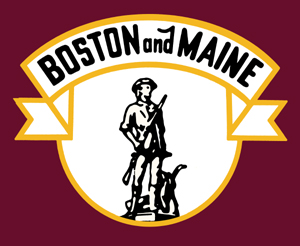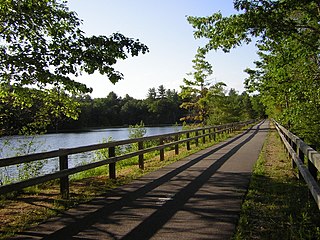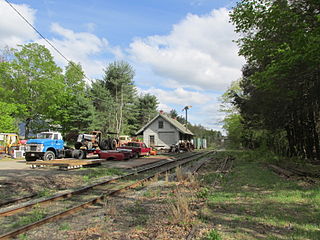
The Boston and Maine Railroad was a U.S. Class I railroad in northern New England. It was chartered in 1835, and became part of what was the Pan Am Railways network in 1983.

Clinton is a town in Worcester County, Massachusetts, United States. The population was 15,428 at the 2020 census.

The Boston and Lowell Railroad was a railroad that operated in Massachusetts in the United States. It was one of the first railroads in North America and the first major one in the state. The line later operated as part of the Boston and Maine Railroad's Southern Division.

The Old Colony Railroad (OC) was a major railroad system, mainly covering southeastern Massachusetts and parts of Rhode Island, which operated from 1845 to 1893. Old Colony trains ran from Boston to points such as Plymouth, Fall River, New Bedford, Newport, Providence, Fitchburg, Lowell and Cape Cod. For many years the Old Colony Railroad Company also operated steamboat and ferry lines, including those of the Fall River Line with express train service from Boston to its wharf in Fall River where passengers boarded luxury liners to New York City. The company also briefly operated a railroad line on Martha's Vineyard, as well as the freight-only Union Freight Railroad in Boston. The OC was named after the "Old Colony", the nickname for the Plymouth Colony.

The New York and New England Railroad (NY&NE) was a railroad connecting southern New York State with Hartford, Connecticut; Providence, Rhode Island; and Boston, Massachusetts. It operated under that name from 1873 to 1893. Prior to 1873 it was known as the Boston, Hartford and Erie Railroad, which had been formed from several smaller railroads that dated back to 1846. After a bankruptcy in 1893, the NY&NE was reorganized and briefly operated as the New England Railroad before being leased to the competing New York, New Haven and Hartford Railroad in 1898.

The Fitchburg Railroad is a former railroad company, which built a railroad line across northern Massachusetts, United States, leading to and through the Hoosac Tunnel. The Fitchburg was leased to the Boston and Maine Railroad in 1900. The main line from Boston to Fitchburg is now operated as the MBTA Fitchburg Line; Pan Am Railways runs freight service on some other portions.
The Central Massachusetts Railroad was a railroad in Massachusetts. The eastern terminus of the line was at North Cambridge Junction where it split off from the Middlesex Central Branch of the Boston and Lowell Railroad in North Cambridge and through which it had access to North Station in Boston. From there, the route ran 98.77 miles west through the modern-day towns of Belmont, Waltham, Weston, Wayland, Sudbury, Hudson, Bolton, Berlin, Clinton, West Boylston, Holden, Rutland, Oakham, Barre, New Braintree, Hardwick, Ware, Palmer, Belchertown, Amherst, and Hadley to its western terminal junction at N. O. Tower in Northampton with the Connecticut River Railroad.

The Mass Central Rail Trail (MCRT) is a partially completed rail trail between Northampton, Massachusetts and Boston along the right-of-way (ROW) of the former Massachusetts Central Railroad and former Central Massachusetts Railroad. It currently has over 60 miles (97 km) open, and 94.5 miles (152.1 km) are open or protected for trail development. When complete, it will be 104 miles (167 km) long through Central Massachusetts and Greater Boston, forming the longest rail trail in New England. Many sections of the trail, including the Norwottuck Branch of the Mass Central Rail Trail and the Somerville Community Path, have been developed as separate projects but serve as part of the complete Mass Central Rail Trail. The Norwottuck Network, a 501(c)(3) nonprofit that supports the build and operation of the MCRT, maintains an interactive map of the MCRT and other Massachusetts trails.

The Nashua River Rail Trail is a 12.5-mile (20.1 km) paved mixed-use rail trail in northern Massachusetts and southern New Hampshire under control of the Massachusetts Department of Conservation and Recreation (DCR). It roughly follows the course of the Nashua River, passing through the towns of Ayer, Groton, Pepperell, and Dunstable, Massachusetts and ends about a mile across the New Hampshire state border in Nashua, New Hampshire. The trail is used by walkers, cyclists, inline skaters, equestrians, and cross-country skiers.

The Framingham Secondary is a railroad line in the U.S. state of Massachusetts. The line runs from Mansfield northwest to Framingham along a former New York, New Haven and Hartford Railroad line. Its south end is at Amtrak's Northeast Corridor, over which CSX has trackage rights to reach the Middleboro Subdivision at Attleboro and the Boston Subdivision in Boston. Its north end is at the Framingham/Worcester Line; the Fitchburg Secondary continues northwest from Framingham.
The Worcester, Nashua and Rochester Railroad was a railroad line that was to link the city of Worcester, Massachusetts, to the city of Portland, Maine, via the New Hampshire cities of Nashua and Rochester, by merging several small shortline railroads together.

The Boston, Clinton, Fitchburg and New Bedford Railroad was a railroad in Massachusetts. It was formed on June 1, 1876, when the Boston, Clinton and Fitchburg Railroad merged with the New Bedford Railroad. The Boston, Clinton and Fitchburg Railroad connected with the key railroad hubs of Worcester, Framingham, and Ayer, as well as several important industrial towns such as Fitchburg and Lowell, with the latter coming through a lease of the Framingham and Lowell Railroad. The New Bedford Railroad linked Framingham with New Bedford, which was a key deep-water port.

Union Station is a railway station located at Washington Square in downtown Worcester, Massachusetts. It is the western terminus of the MBTA Commuter Rail Framingham/Worcester Line and a stop for the Amtrak Lake Shore Limited service. A bus terminal adjacent to the station is the hub for Worcester Regional Transit Authority (WRTA) local bus service; it is also used by PVTA, MART, Peter Pan, and Greyhound intercity buses.

The Fitchburg and Worcester Railroad was a railroad in Massachusetts. It was incorporated in 1840 to provide a rail connection between Fitchburg and Worcester. Service began on February 11, 1850, running 18 miles from Fitchburg through Leominster and Sterling to Sterling Junction, where it connected with the Worcester and Nashua Railroad.

The Agricultural Branch Railroad was a railroad in Massachusetts. It was incorporated by the Legislature of Massachusetts on April 26, 1847, to provide a rail connection between Framingham and Northborough through the town of Southborough and a small portion of the city of Marlborough. Service began on December 1, 1855.

The Framingham and Lowell Railroad was a railroad in Middlesex County, Massachusetts. It was incorporated in 1870 to provide a rail connection between the growing railroad hub of Framingham and the important mill city of Lowell, passing through the towns of Sudbury, Concord, Acton, Carlisle, Westford and Chelmsford. The 26.1 mile line opened on October 1, 1871.

The Boston, Barre and Gardner Railroad was a railroad in Massachusetts that connected Worcester and Winchendon via Gardner. It was originally chartered as the Barre and Worcester Railroad in 1847, before being renamed the Boston, Barre and Gardner Railroad in 1849. The company was unable to raise funds for construction until 1869; service between Worcester and Gardner began in 1871. An extension northward to Winchendon was completed in January 1874. The Boston, Barre and Gardner operated independently until it was taken over by the Fitchburg Railroad in 1885. Despite the company's name, it never served Boston or Barre. The line was abandoned between Winchendon and Gardner in 1959 by the Fitchburg's successor, the Boston and Maine Railroad. In the 21st century, freight service on the remainder of the line is operated by the Providence and Worcester Railroad between Worcester and Gardner, and by Pan Am Railways on a short segment in Gardner.
The Taunton and Middleborough Railroad was a railroad in Massachusetts. It was incorporated in 1848 to connect the Taunton Branch Railroad in Weir Village, Taunton with the Fall River Railroad and newly built Cape Cod Branch Railroad in Middleborough through the town of Raynham. In 1853, the railroad changed its name to the Middleborough and Taunton Railroad.

The Nashua, Acton and Boston Railroad (NA&B) was a railroad formed in 1871 to build a line between Nashua, New Hampshire, and Acton, Massachusetts. After opening in 1873, the railroad expanded to Concord, Massachusetts, and offered a commuter connection to Boston. It was leased by the Concord Railroad in 1876, with the lease later passing to the Boston and Maine Railroad in 1895. Most of the railroad line was abandoned in the 1920s, though a short portion in Nashua continued to be operated until 1980.

The Worcester Consolidated Street Railway (WCSR) was a streetcar and later bus system in Worcester, Massachusetts, and surrounding areas of Central Massachusetts. Its earliest predecessor opened in 1863 and its final successor closed in 1978. The third-largest streetcar system in Massachusetts, it operated a dense network of urban lines in Worcester plus rural lines across Central Massachusetts. At peak size in the late 1910s, it operated 547 streetcars over 252 miles (406 km) of track, carrying 69.8 million annual passengers over 40 routes. The WCSR had a number of powerhouses and carhouses, many inherited from other companies it acquired. Freight service was operated from 1912 to 1927.



















